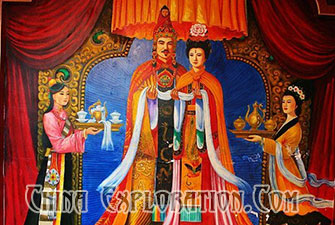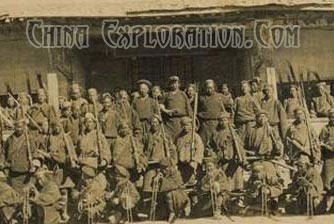Recorded Tibetan history begins in the 7th century AD when Tibetan armies were considered as great a scourge to their neighbors as the Huns were to Europe . Under King Songtsen Gampo, the Tibetans occupied Nepal and collected tribute from parts of Yunnan.
Shortly after the death of Gampo, the armies moved north and took control of the Silk Road, including the great city of Kashgar . Opposed by Chinese troops, who occupied all of Xinjiang under the Tang dynasty.
It was not until 842 that Tibetan expansion came to a sudden halt with the assassination of the king, and the region broke up into independent feuding principalities. Never again would the Tibetan armies leave their high plateau.
In ancient times, the Tibetans on the plateau cultivated a close relationship with the Han and with other ethnic groups from the Chinese interior. In the 7th century, this relationship reached its peak when Srong-btsan Sgam-po (Songtsan Gambol, the king of the Tubo kingdom who ruled the Tibetan Plateau at that time twice sent envoys to the Tang Dynasty emperor to propose to Princess Wen Cheng who he later married.
The Tibetans and Hans had through the marriage of their royal families and various meetings, formed close economic and cultural relations, laying the groundwork for the ultimate foundation of a unified nation. In Lhasa , the capital of the Tibet Autonomous Region, the statue of Princess Wen Cheng is still enshrined and worshiped in the Potala Palace.The Monument to the Alliance between the Tibetans and the Han erected in the 9th century still stands in the square in front of the Jokhang Temple.
Relations between Tibet and China continued to develop afterwards. In the 13th century, the ruler of Tibet met a Yuan Dynasty prince and officially decided on the terms for Tibetan submission to China including presenting the prince with map and census books, the payment of tributes and the acceptance of rule by appointed officials. From then on, Tibet was an official administrative region of China.This happened 200 years before Columbus' discovery of the Americas.
In the following several hundred years, though there were shifts in the political power of the central government and the local Tibetan government alike, relations between them became more and more close, and Tibet's position as an administrative region of China has never changed.
Rulers of both the Ming Dynasty, founded in the 14th century, and the Qing Dynasty founded in the 17th century were directly responsible for the appointment of Tibets ' local officials, as well as for the selection of high commissioners stationed in Tibet to supervise local administration on behalf of the central authorities.
The majority of Tibetans believe in Tibetan Buddhism of which many sects developed during Tibet's long history. When Buddhism reached Tibet in the 3rd century, it had to compete with Bon, the traditional animistic religion of the region. Buddhism adopted many of the rituals of Bon, and this, combined with the esoteric practices of Tantric Buddhism (imported from India)provided the basis from which Tibetan Buddhism evolved.
The religion had spread through Tibet by the 7th century; After the establishment of the Qing Dynasty in the 17th century, the emperors granted honorific titles to the 5th Dalai Lama and the 5th Baingen Erdeni of the Gelukpa sect in 1653 and 1713 respectively henceforth officially establishing the titles of the Dalai Lama and the Baingen Erdeni and their political and religious status in Tibet. The Dalai Lama in Lhasa ruled most of Tibetwhile the Baingen Erdeni ruled the remaining area from Xigaze.
The Chinese emperors also enacted regulations stipulating that the selection of children said to be the reincarnations of the Dalai Lama or Panchen Lama should be reported to the imperial court for approval, and that the central government would send high officials to supervise in person.
The discovery of the 14th Dalai Lama who is in exile at present was indeed reported to the central government by the Tibetan local government in the traditional manner after the death of the 13th Dalai Lama. In 1940 the Chairman of the national government issued an official decree conferring the title of the Dalai Lama.
After the People's Republic of China was founded, the central government notified local Tibetan authorities to ''send delegates to Beijing to negotiate the peaceful liberation of Tibet''. On 23rd May 1951, the ''17-Article Agreement'' was signed after delegates from the central government and the local Tibetan government reached agreement on a series of questions concerning Tibet 's peaceful liberation.
The Dalai Lama sent a telegram and the Panchen Lama issued a statement both supporting the ''17-Article Agreement'' and expressing their de sires to ''safeguard the unification of the motherland and her territorial sovereignty.''
Related Tours











